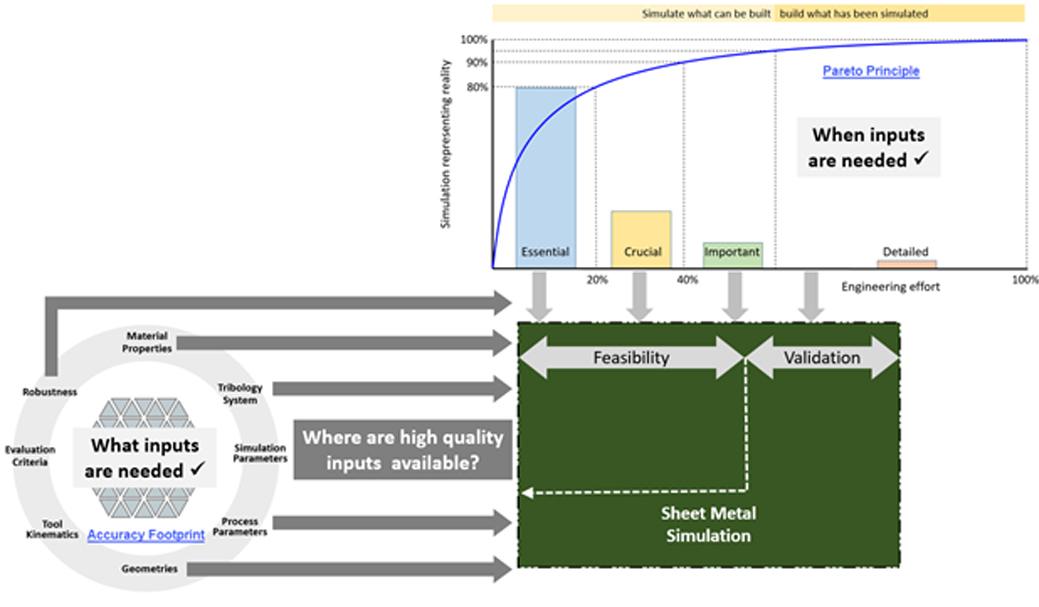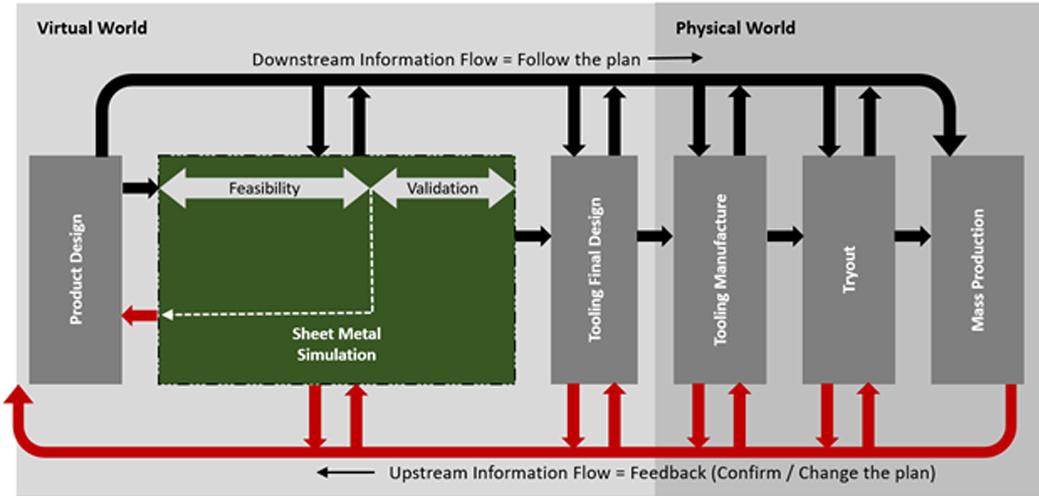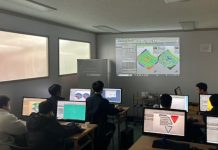Manufacturing a product that meets quality targets in the most efficient manner possible is the overarching goal of the sheet metal industry. This means the accuracy and performance of a product must meet specifications while minimizing the associated time and costs.
Today, there is pressure to improve all outputs, especially cost and time-to-delivery. With this in mind, almost everyone in the industry has integrated simulation technology into their development process in order to advance their competitiveness. In many cases, simulations are relied upon to facilitate the elimination of prototyping and related builds in order to improve time-to-delivery and associated costs significantly. However, with increased reliance comes the need to ensure simulation results can predict what will happen in the physical world.
If we think of the sheet metal product process chain from a systems engineering viewpoint, we can begin to identify and improve the system components required to ensure simulation matches reality. Any system with long-term success requires control of inputs and outputs.

System Inputs
We will start with a discussion of inputs. Identification of initial required inputs and application of those inputs at an appropriate time is required. For this reason, the AutoForm Accuracy Footprint was developed to assist with the understanding of what inputs are needed. At the same time, the AutoForm Pareto Principle provides a guideline for when those inputs are required for efficient simulation development.
However, knowing what inputs are needed does not mean it is easy to obtain them. An effective system must also clearly identify where required inputs can be obtained and how inputs are verified to be of a sufficient quality level. Input data is not always readily available, and many times where to acquire it is not known by engineers working on the simulation. This leads to using whatever data is available, even if that is simply the default, without fully understanding if that is appropriate. This situation must be addressed if simulation accuracy is critical to success.
(Click to enlarge)
Although required inputs and when they should be applied can be generalized across organizations, the source of inputs and how verification takes place must be defined by the specific organization. Engineers need to ensure they have a strong organizational understanding. This will enable them to answer critical questions such as who produces and fully understands the input data, if they are an internal or external resource, and can the needed input data be acquired from this source directly. If the data cannot currently be easily obtained from a source, additional steps must be taken.
Many times improved organizational cooperation is needed to alleviate access issues. This may require justification based on a clear business need, such as project ROI achievement coupled with management support to convince all stakeholders that sharing information is required to meet targets. Although not an easy task, it will be worth the effort in the long run. Finally, once these connections are established, they will need to be maintained to reflect changes to inputs over time into the system.
System Outputs
Now we can discuss the outputs. Monitoring and maintaining the system to ensure outputs meet requirements is another critical focus to ensure system performance. A system’s outputs should be vigorously monitored to identify deficiencies (current and potential), and their root causes so that they can then be resolved through actions to correct errors, prevent future issues, and to add needed functions. By doing this, the system is in a state of continual improvement both during a single project and from one project to the next. Keep in mind that the outputs of one part of the system (process chain) are often inputs for another.
System Visibility
So from an overall viewpoint, proper visibility of critical system inputs and outputs is needed across the entire process chain to facilitate optimal system performance over time.
(Click to enlarge)
The proper visibility and flow of information downstream facilitates “building what has been simulated”. This is a requirement to achieve simulation accuracy when compared to reality. If the engineering intent isn’t easily visible and understood downstream, it is unlikely that it will be maintained.
For example, suppose the intended (simulation based) draw-in amount is 30 mm in a specific area and that is not properly communicated to the trial team. In that case, the same region may be adjusted to allow 15 mm of flow to eliminate cracking during an initial die trial. This would likely seem to be a good result to the trial team, but since the flow does not truly match engineering intent, the final part quality is at risk due to a probable change in springback results.
Ensuring all required team members receive and fully understand the engineering intent and that it is based on a comprehensive analysis is the first step in maintaining the vital connection between the virtual and physical worlds. In simple terms, when people understand expectations and why they were established, they are far more likely to adhere to a plan — and if they can’t, they communicate any variance back to the appropriate people.
The proper visibility and flow of information upstream facilitates “simulating what can / should be built.” This is also a requirement to achieve simulation accuracy when compared to reality. If the physical world conditions are not easily visible and understood upstream, they cannot be appropriately reflected to the simulation inputs.
For example, if an aging press line currently has a cushion force variation of 10% despite the original press specification being 5% variation, this could lead to stability issues in production if the simulation engineering team does not understand the press line decline in actual capability. The reverse could also be true if a press line is replaced with upgraded technology. If smaller variation and improved capabilities are not included in the simulation optimization, then product design and stamping processes can be overly conservative and result in wasted resources or a less appealing product for customers. These types of problems can be avoided with the proper visibility of system information and the utilization of simulation to predict the impact of seemingly minor changes.
Where to start
To conclude our discussion, it may be helpful to ask yourself some basic questions when setting up a simulation:
- Is it clear what inputs are required to expect an accurate simulation?
- Do I know when to apply or refine the inputs to efficiently optimize my process using simulation?
- Where is the best source to acquire each needed input?
- Is it clear how inputs are regularly validated to be of high quality?
- Do critical downstream stakeholders have access to and understand the simulation output?
- Do I get regular and sufficient feedback from downstream stakeholders regarding differences between simulation and reality for both inputs and outputs?
- Are changes to inputs communicated and understood far enough upstream to prevent issue recurrence?
Whenever the answer to one of these questions is no, an area for potential enhancement is indicated. These questions will take time and effort to answer fully, but knowing where improvement is potentially needed and applying incremental system improvements should ultimately lead to better outcomes.















